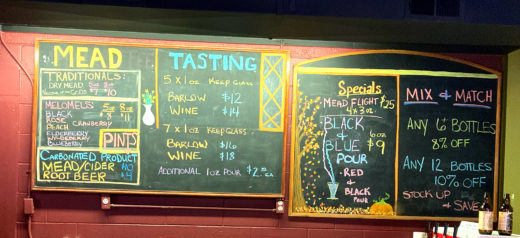From spokesman.com
By Thomas Croskrey
Here is everything you ever wanted to know about mead but were afraid to ask:
Origin: No single culture is credited with inventing mead. Some cultures that have a strong, ancient mead practice include the Cymry (Welsh) and other Insular Celts, Nordic peoples, Chinese, North African and Ethiopian.
Historical evidence suggests that they all independently invented the beverage without interaction. The oldest example of mead that historians have found is from about 7,000 years ago in China – it was likely co-fermented with rice. The oldest European example is about 2,500 years old out of present-day Scotland but was likely produced throughout Europe before that.
Etymology: There are several etymological theories for the word mead. My favorite comes from the Cymry word medd (pronounced similarly like meth), which means medicine. It shares etymology with methamphetamine. Mead was often used as medicine in Wales, especially when infused with botanicals, making it a methaglyn.
Style names: Style names for mead are varied and interesting, many sounding like magic words or spell names. Style names are mostly driven by their ingredients more than where the style originated, although there are examples of geographic styles, too, like Tej out of Ethiopia, all of Poland’s mead styles or chouchen out of Brittany.
Typically, if a mead is infused with botanicals, it’s called a methaglyn or metheglin. Fruited meads are called melomel. Meads produced with grain or malt are called braggot. Bochet, a style out of France, is the style of mead that uses caramelized or cooked honey.
There are subcategories like pyment, which is a melomel produced with grapes, or cyser (either sye-zer or kye-zer), which is a melomel produced with apples. There are a few references for a mead made with only water, honey and yeast, and I call that a simple mead. Assigning style names to hybrids can become a headache, so approaches vary.

Hierophant’s lavender citrus mead at Hierophant Meadery, 16602 N. Day Mt. Spokane Road, in the Green Bluff area of Mead. (Courtesy of Ari Nordhagen)Obscurity: Mead has had such a back-and-forth existence owing largely to the expense and difficulty of producing such large amounts of honey. Mead mostly has been considered upper class or even mystical. That obscurity has confused many U.S. regulators and lawmakers.
Mead is not beer (alcohol from grain sugar). Mead is not wine (alcohol from grapes or possibly other fruit sugar). Mead is so different from other alcoholic beverages, it’s the only one that’s not produced from plant sugar.
It’s unfortunate that mead is lumped in with wine regulation in the U.S. It gives people (especially consumers) the wrong idea about mead, and then us producers have an even more difficult job selling our products – or we just go along with the misinformation.
Production: Dissolving sugar in water is relatively easy, but hitting all the exacts and taking care of the yeast is where it gets laborious and time-consuming. Typically, must (the honey-water solution before being fermented) is only heated enough to get honey dissolved in water, as opposed to brewing beer, which has a mash period at about 150 degrees and then a boil period.
The most important facet to mead production is yeast care. Healthy yeast makes tasty mead, and unhealthy yeast makes off-flavours. Mead is known to take years to ferment and be drinkable, but that’s when proper yeast care isn’t in place.
Proper nutrient and O2 additions, along with other details including temperature control, will keep yeast healthy and vibrant, making fermentation for mead last just a few weeks.
Honey: Mead is defined as “fermented honey in water.” Honey varietals and terroir make mead fairly inconsistent in flavour profiles. Making two batches of mead in identical ways except using different honey varietals will make two completely different meads. My approach is to celebrate the variances derived from terroir and varietal rather than try to fight it.
I want consistently tasty, consistent quality and consistent integrity, not consistent sameness. If subbing out honey varietals becomes necessary, there are ways of making good substitutes such as keeping like-kind honeys together according to colour, flavour and richness. Subbing mint blossom honey (very dark) for fireweed blossom honey (very light) would be a mistake.
In general: Mead is in a renaissance – truly and genuinely in a rebirth period. Mead is the fastest-growing sector within craft beverage, but there are growing pains. U.S. regulators haven’t really put a lot of thought into where to categorize mead or how to regulate it, so it has been assigned to the wine industry – and there are difficulties in sharing that space rather than mead having a space of its own.
Also, given the cosmopolitan originations of mead, producers can follow vastly different traditions in terminology and practices. My favourite phrase that I’ve been using for years is “there are hundreds of ways to do it right.”
That said, I do hope the mead industry can start unifying in a bit more approachable way for the public. I think the public has a tendency to be a little timid about mead because of the obscurity, and our industry seemingly not having it together compounds the issue.
https://www.spokesman.com/stories/2022/jun/01/notes-on-mead-first-of-all-mead-is-not-beer/
.png.gallery.jpg)




